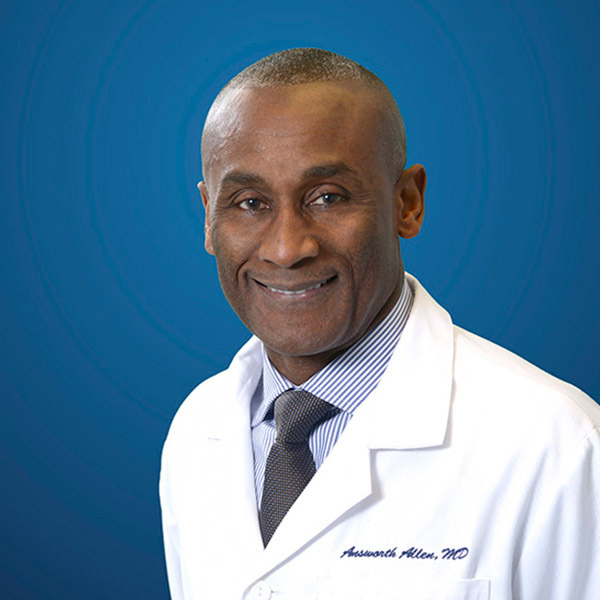What is shoulder arthritis?
There are three joints located within the shoulder: the acromioclavicular joint, the glenohumeral joint, and the sternoclavicular joint. These joints are formed from the connection between two bones. The ends of these two bones are coated by a layer of cartilage to aid in joint movement and allow the bones to glide over each other without pain. Shoulder arthritis occurs when the cartilage becomes worn or damaged, resulting in bone-on-bone movement. Narrowing of the joint space, osteophytes (bone spurs), and sclerosis (dense bone) are some classic findings of shoulder arthritis. This condition can cause joint damage, chronic pain, and, in some cases, loss of movement. Dr. Answorth A. Allen, orthopedic shoulder specialist serving patients in Manhattan, New York City, Westchester, Long Island and surrounding areas, has the knowledge and understanding, as well as substantial experience in treating patients who are experiencing the symptoms of shoulder arthritis.

Are there different types of shoulder arthritis?
Two of the three joints within the shoulder can be affected by arthritis: the acromioclavicular joint, where the highest portion of the shoulder (acromion) connects with the clavicle (collarbone), and the glenohumeral joint, where the ball of the humerus (upper arm bone) connects with the glenoid portion of the scapula (shoulder blade). One or more of the following types of arthritis can affect these shoulder joints:
Osteoarthritis: This “wear-and-tear” form of arthritis is the result of cartilage degeneration from chronic shoulder use. This painful condition is common among patients over the age of 50.
Rheumatoid Arthritis: This autoimmune form of arthritis is the result of the body’s own immune system attacking and destroying the articular cartilage in the joints. The synovial lining that lubricates the shoulder joint is also known to swell with this type of arthritis.
Rotator Cuff Arthritis: This specific form of arthritis, also called rotator cuff tear arthropathy, is the result of a rotator cuff tendon tear. The improper function of muscles and tendons can lead to abnormal wearing of the shoulder cartilage. This can generate pain, weakness, and difficulty with shoulder movement.
Post-traumatic Arthritis: As the name suggests, this form of arthritis is the result of an injury. Previous shoulder dislocations, especially multiple episodes, can damage the surface of the cartilage leading to bone-on-bone movement.
What are the symptoms of shoulder arthritis?
A common complaint among all types of shoulder arthritis is shoulder pain that can vary from a dull ache to episodes of sharp and intense pain. Other symptoms include:
- Worsening pain at night, especially with active shoulder use throughout the day
- Decreased range of motion
- Shoulder weakness and stiffness
- A grinding or catching sensation with shoulder movement
- Difficulty moving or lifting the affected arm, especially overhead or behind the back
- Crepitus: a cracking or crunching sound in the shoulder with movement
How is shoulder arthritis diagnosed?
A comprehensive medical history will be obtained by Dr. Allen; additionally, a thorough physical examination will be conducted to include an assessment of shoulder mobility as well as evaluating for areas of shoulder pain and tenderness. Diagnostic imaging such as x-rays will show if there is bone damage. Magnetic resonance imaging (MRI) may also be requested to confirm the diagnosis of shoulder arthritis and identify the amount of damage to the articular cartilage as well as any other structures within the shoulder.
What is the treatment for shoulder arthritis?
Non-surgical treatment:
Patients with mild to moderate shoulder arthritis are able to resolve their symptoms with conservative treatments alone. A combination of rest, alternating ice and heat application, and non-steroidal anti-inflammatory medications can be used for pain management and to minimize swelling. If these symptoms are not relieved with oral medications, a corticosteroid injection can be administered directly into the shoulder. Another alternative option is hyaluronic acid or viscosupplementation injection, which may provide lubrication to the joint and control pain for an extended amount of time. A physical rehabilitation program aimed at improving shoulder strength and range of motion may also be recommended.
Surgical treatment:
In the event of unsuccessful conservative therapy, or if a patient experiences more severe symptoms, surgical intervention may be necessary. Dr. Allen will design an individualized treatment plan based upon the severity and complexity of symptoms as well as the patient’s age and activity level. Some treatment options include the following:
- Shoulder Arthroscopy: This procedure employs a small camera (arthroscope) to view the muscles, tendons, and ligaments within the shoulder. Specialized surgical instruments are then used to excise degraded cartilage or smooth out the synovial lining. This minimally invasive surgical approach can relieve pain and other associated symptoms; however, it will not prevent further arthritic damage to the shoulder.
- Shoulder Replacement: Also known as shoulder arthroplasty, replacing the shoulder joint may be recommended in severe cases of shoulder arthritis. This open surgery uses plastic and metal pieces to create new joint surfaces in the shoulder. A metal ball, called a prosthesis, replaces the arthritic ball of the humerus by attaching it to a metal stem placed inside the bone. A plastic piece is used to cover the arthritic socket. The motion of the smooth metal ball against the new plastic socket relieves pain and prevents the inflammation experienced with bone-on-bone arthritis. This surgical approach is reserved for older patients and is used as a last resort treatment because this joint replacement lasts approximately 10-20 years.
Shoulder Arthritis Specialist

Shoulder arthritis is a condition that develops over time as cartilage in the shoulder wears down. This condition causes pain and decreased range of motion in the shoulder, as well as possible joint damage. Shoulder surgeon Doctor Answorth Allen provides diagnosis and treatment plans for patients in Manhattan, New York City, Westchester, Long Island and surrounding areas who experience shoulder pain and decreased range of motion. Contact Dr. Allen’s team today!






